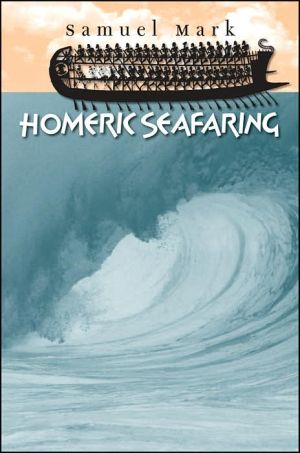

 |

|

The average rating for Homeric Seafaring (Ed Rachal Foundation Nautical Archaeolog Series) based on 2 reviews is 4.5 stars.
Review # 1 was written on 2013-05-23 00:00:00 John Smith John SmithReview of Homeric Seafaring by Samuel Mark 06/14/13 This book is an almost dissertation level publication that practically requires a background in ancient seamanship, shipbuilding, Mediterranean geography, and a pretty thorough review of writings attributed to Homer. You might want to read this in a very good library to have reference materials at hand, such as Lionel Casson's works on ancient ships and seamanship of seafarers. Being able to read Greek will probably help, as there are chapters where every acclaimed literary historian of Bronze age naval designs and techniques is referenced for their interpretation of specific words in the Homeric novels, and what parts of a ship those words apply to and how the application fits. This is great stuff if you have the background for ancient shipbuilding that is no longer in common use today. Or you will better understand the implications of the text if you are able to relate the textual topics to practical aspects of open boat ocean sailing and rowing that can be experienced today. To get a feel for how the word translation of ship parts is affected by the word's usage you might consider an analogy. Assume that you are whisked 3000 years into the future to observe an archaeological team in Amarillo, TX digging up the famous buried Cadillacs. They don't speak English, which has been a dead language for at least a thousand years. Almost all of our contemporary paper products such as books and magazines have been lost over time, as well as any plastic based data storage products such as CD's, magnetic tape, and flash drives. Our current culture has been lost over time. The archaeological team has at their collective disposal the remnants of one Webster's dictionary and scraps of preserved written articles which have been buried for almost 3000 years and exist as fragments. One article refers to Cadillacs as "hot" cars and there is a quote from a celebrity that the "fins are cool". In looking up the definition of cool, the researchers determine that the cars must have had very heated engines, and that the exaggerated fender fins served as cooling radiators to help reduce the running heat. The phrase "Cool" as applied to car fins has lost its mid twentieth century applicable reference meaning, leaving the archaeologists of the future to quibble amongst themselves and attempt to reconstruct the purpose of outdated car parts. To some extent, the Homeric word usage has lead to this exact scenario in attempting to piece together representative ship types which were probably common in Pre-Homeric Greek times, but of which there are almost no existing artifacts, and no actual ships from shipwrecks have been found. The criticisms I have for this work are that there should have been more maps, and the maps should be legible without a magnifying glass. One map provided showed conjectural sailing routes and event locations for scenes in the Odyssey, however it was on such a compressed scale that without magnification it couldn't be read. I make this statement as someone who has always used compressed fonts on high resolution displays - it's not the lack of eyesight, it was a presentational opportunity missed. Also I would like to see historical authors begin to incorporate a visual timeline presentation so that when terms, people, and historical locations are referred to, one quick glance will position that item in reference to time intervals before and after the writing in question. For example, Troy VII may be the Troy referred to as Homeric Troy, but without a lookup, the reader doesn't know what year that may be. If Troy VIIa is dated at approximately 1300 BC, and Homer lived at approximately 800-900 BC, then on a timeline it is easy to visualize that he was writing about events that had occurred 300-500 years prior. The references to geometric ship art on pottery would refer to 900-700BC, and could quickly be visualized to be more contemporary to Homer and thus probably represent more advanced building techniques and design than ships used at the time of the attack on Troy, by the same 300-500 year interval. Without the visual timeline, references to people, places, and literary references by name, tend to become congested and distracting in terms of constantly requiring reference lookups to glean the comprehensive time shift an author may be suggesting by the use of his terms and references. Only the very knowledgeable students, accomplices of the author, or distinguished historians might be able to reference all events and terms and correctly time sequence the events to fit the historical narrative. As an interested reader, I took the burdensome challenge of researching terms and event timelines, and it distracted from the delivery of the books message, and resulted in an exceedingly slow completion of the narrative conclusions. |
Review # 2 was written on 2013-07-12 00:00:00 Nisha Kothari Nisha KothariGreat book to read as a companion to either Homeric Epics, but especially the Odyssey. A bit on the technical side throughout, but not overwhelmingly or off puttingly so. The topics discussed range from archeology, the changes in ship design in the bronze and archaic ages, etymology, geography and ethnography. Peppered throughout are summations of existing scholarly opinions in these fields and the author does a good job of addressing them in an even handed fashion. A very good read! |
CAN'T FIND WHAT YOU'RE LOOKING FOR? CLICK HERE!!!